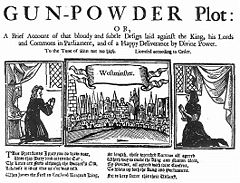
I know that the Gunpowder Plot happened over two years after Elizabeth I died, in the reign of her successor King James I, but as the wonderful article by BBC History Magazine points out, the plot actually had its origins in Elizabeth’s reign.
Why?
Because Elizabeth had continued the work of Henry VIII and Edward VI and made England a Protestant country. By the end of Elizabeth’s reign, England was a dangerous place for Catholics, with the threat of persecution and even death hanging over them. As Elizabeth’s health deteriorated, the Catholics pinned their hopes of James VI of Scotland who was married to a Catholic and who was the son of the late Catholic queen, Mary Queen of Scots. Although he himself was a Protestant, the Catholics felt sure that he would be sympathetic to their cause.
James VI of Scotland became James I of England in 1603, on Elizabeth’s death and although his reign started well for the Catholics, with James limiting the restrictions on Catholics, things took a turn for the worse when, after opposition from Protestants, James reversed his policy less than a year after implementing it. The Catholics’ hopes were dashed and they felt betrayed. One party of young Catholics, headed by Robert Catesby, a popular and rebellious young man at court, decided to seek revenge through rebellion. They met in London in May 1604 and hatched a plan to blow up the Palace of Westminster, on the opening session of Parliament, thus killing the King, the Royal family, members of Parliament (MPs), the Lords and the leading bishops. This would be the first step in their rebellion which sought to replace James I with his daughter, nine year old Princess Elizabeth, as a Catholic queen.
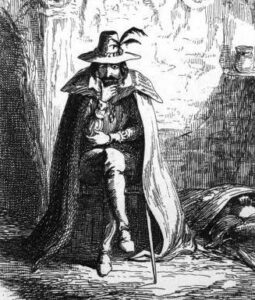
The Plot
One of the plotters, Thomas Percy, a member of the King’s Bodyguard, was able to lease lodgings that were situated adjacent to the House of Lords and the idea was that the plotters would dig down underneath the foundations of the House of Lords and place gunpowder there. Guy Fawkes (also known as Guido Fawkes), a man who had been fighting for the Spanish in the Low Countries, was the man chosen to put the plan into operation by preparing the gunpowder and lighting the fuse, and he posed as Percy’s servant, calling himself John Johnson so that he could stay in the property.
The Black Plague of summer 1604 meant that the plan had to be changed due to the opening of Parliament being delayed. However, this delay worked in the mens’ favour because during this time they learned of a vacant ground-floor undercroft directly under the House of Lords Chamber. Thomas Percy was able to secure the lease of this undercroft and Guy Fawkes, and other members of the group, set about filling this space with 36 barrels of gunpowder, which had the potential to completely level the Palace of Westminster.
What Went Wrong?
Everything seemed fine and the plot looked as if it would be successful until Lord Monteagle received an anonymous tip-off just over a week before the state opening of Parliament was due to take place. The letter, thought to be from Lord Monteagle’s brother-in-law, Sir Francis Tresham, who had recently become a member of the plot, gave enough details of the plot for Lord Monteagle to go to Robert Cecil. Cecil took the news to the King who ordered the cellars beneath Westminster to be searched, it was on the night of the 4th/5th November that Guy Fawkes was found red-handed with the evidence – 36 barrels of gunpowder!
Guy Fawkes was arrested and tortured for information, but despite this failure Catesby still attempted to incite armed rebellion in the Midland, it too was a failure and Catesby, along with a few of his co-conspirators, in a shoot-out on 8th November. Those who weren’t killed were arrested, tried and then hanged, drawn and quartered in January 1606.
On 5th November 1605, Londoners were encouraged to celebrate the King’s narrow escape by lighting bonfires around the city and it is that celebration that is remembered in the UK every year on 5th November, along with the fireworks which have their origins in Guy Fawkes’ gunpowder. In fact, this celebration to give thanks for the deliverance of the King was made compulsory in the United Kingdom until 1859.
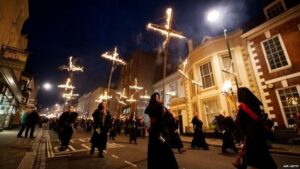
Remember, Remember the 5th of November
There are many customs associated with Guy Fawkes Night (Bonfire Night):-
- Firework displays – both private and public events
- Penny for the Guy – In some places children still go round collecting money, with an effigy of Guy Fawkes in a wheelbarrow, saying “A Penny for the Guy”. This money would be used to buy fireworks. This practice is now not so widespread because children can’t buy fireworks.
- Bonfires – Effigies of Guy Fawkes, made from clothes stuffed with newspaper or straw, are burned on bonfires.
- Traditional food – Food associated with Bonfire Night and enjoyed at parties include Toffee Apples and jacket potatoes which are cooked in the embers of the fire (or in ovens!). Other traditional foods which I have never tried on Bonfire Night include black peas with vinegar, groaty pudding (in the Black Country) and Potato Pie with pickled red cabbage.
- Firework processions – Some towns and villages have special torchlit processions with marching bands, floats and people dressed up in elaborate costumes from the local bonfire societies. The one I’ve been to in East Hoathly, East Sussex is wonderful and you can follow the procession to the field where the bonfires are lit, Guy Fawkes is burned and spectacular fireworks are let off – wonderful!
- Sparklers – metal rods held in the hand which, once lit, emit sparks and coloured flames. I used to love these as a child but they are not so popular now because of the fear of injury.
The traditional rhyme which is said on Guy Fawkes Night is:-
Remember, remember the Fifth of November,
The Gunpowder Treason and Plot,
I know of no reason
Why the Gunpowder Treason
Should ever be forgot.
Guy Fawkes, Guy Fawkes, t’was his intent
To blow up the King and Parli’ment.
Three-score barrels of powder below
To prove old England’s overthrow;
By God’s providence he was catch’d
With a dark lantern and burning match.
Holloa boys, holloa boys, let the bells ring.
Holloa boys, holloa boys, God save the King!
As the UK has a Queen on the throne at present, the last part of the last line is changed to “God save the Queen”.
Places to Visit
There are various historical houses which have links to the Gunpowder Plot and you can read all about them in the article by BBC History Magazine – click here – but here they are with links to their websites:-
- Baddesley Clinton, Warwickshire
- Banqueting House, London
- Alnwick Castle, Northumberland
- Guy Fawkes Inn, York
- The Palace of Westminster (Houses of Parliament), London
- Warwick Castle, Warwickshire
- Hagley Hall, Worcestershire
- Coughton Court, Warwickshire
- The Tower of London, London
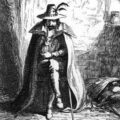

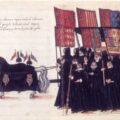
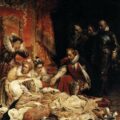
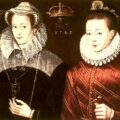


It is a pity, but with each year, the actual date of celebration becomes less and less associated with the 5th of the month, and is instead moved to the nearest convenient weekend – Friday or Saturday. We cannot really do much in England now unless it is accompanied by a lot of eating and drinking of alcohol, so it has to be on an eve when the grown-ups don’t have to rise early for work the next day.
As I write this there is hardly a sound of a firework to be heard – just once in a while. And also, private celebrations are more or less a thing of the past – as health and safety concerns encourage everyone to go to big organised displays, instead.
When I was a child (a good while ago, it has to be said) every garden had children with their parents letting off a few modest fireworks, and sharing them too with one another. Bonfires were always lit, and it was a great event, anticipated for weeks.
We used to keep a cardboard box full of fireworks under our beds, and each few days a new one would be added. The idea of shifting firework night to anytime other than the 5th would have been regarded with disbelief and horror!
Enough nostalgia for one day. Lovely article, Clarie.
It’s been going on round here all week and will continue for another three, if I know this place! When while my senile dog is shaking, junior dog is barking at them all (cavalier King Charles, and oh so bossy!). Jasper the Persian endures it stoically and liitle mad tortoiseshell hides under the kitchen table on a pushed in chair 🙁
Sounds like the fourth of July in many ways. The day before, many pet owners go to the vet and get a sedative for their animals. I live about 10 miles from a popular fireworks sight and I learned never to take the cat to the vet on the 3rd!
It’s still continuing, Lisaannejane!
Your poor pets! One day of fireworks is okay, but more than that would be annoying. Maybe Parliament should pass an official November 5 Guy Hawke’s Day. Keep your traditions and save your pets. Too much celebrating is not a good thing.
We burn Guy Fawlkes in effigy on bomb fires, but we should burn Robert Catesby as it was his brain child, the plot of 1605. Guy Fawlkes was the explosives expert, but he was not the main man, the others brought him in for his expertise. He was not known to the authorities, which means he did not have any criminal connections. Thomas Percy, Wintour and others all had good cause to take place in this plot: James betrayed them and went back on his promise of toleration. Robert Cecil may also have set them up and it is possible that he was also behind the plot, or its conception, to blame Catholics for killing James and to incite a bloodbath, which would have resulted had the plot succeeded.
Mark well: this plot almost succeeded. It would have killed James, his council, his government, other members of the royal family, namely Prince Henry and Prince Charles; it would have killed all 150 or so members of Parliament and there would have been chaos. What happened next would have depended on whether or not the plotters could have kidnapped Princess Elizabeth and if thousands of other people joined them. If not, would some of them have escaped to France? Yes, they had boats waiting.
Bloodbath?
The historians like to think a blood bath would have followed. That also depends on the plotters failing to gain support. There would be no-one left to arrest them: the government is dead. A new Government would need to be created, one that the plotters would form. But that does not mean that revenge killings would not have followed, and the number of deaths may have been terrible. But in the end, a Government would have needed to be formed and Elizabeth, the Princess, for all of her fine words that she would never be Queen under these circumstances, would have been forced to call for calm and to unite the two sides. She would be a puppet Queen, if support could be found, but then, may-be Catholics and Protestants may have been outraged with the murder of the king.
We should not celebrate the Gunpowder plot today. It is inciting religious hatred and the noise is terrible and what about the injured kids that hospitals have to deal with every year. Official displays only and let the rest of us have some peace and quiet. I do not wish to be a kill joy, but if we want to celebrate this stupid anniversary, then it should only be in a controlled way and not with fireworks being thrown in the streets and going off at all hours of the night and early morning for weeks before and afterwards.
And as for James I; he caused the problem in the first place, by first of all relaxing the cruel laws against Catholics and then changing his mind and trying to destroy them. He would have made Catholics outlaws and the life for them here would have been intolerable. We are lucky, we do not know what torture and persecution are; we do not know what it is to have to hide and to live in terror and pay fines to the state for our religious faith; they did! James made a pact to reduce the fines and to allow Catholics to have some freedom; they then came out into the open and he panicked and changed his mind. He went to the other extreme and banished Catholics from England. The men of the Gunpowder Plot were desperate, they did not have any other option but to get rid of this king; but James caused the problem. He was not being very wise this time; no wonder he is also called foolish: the wisest fool in Christendom.